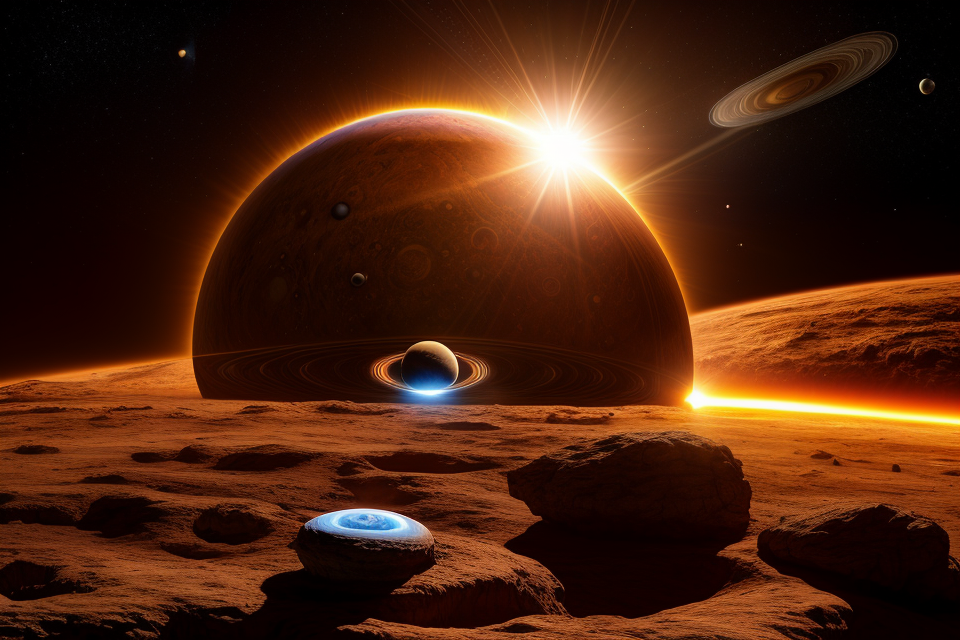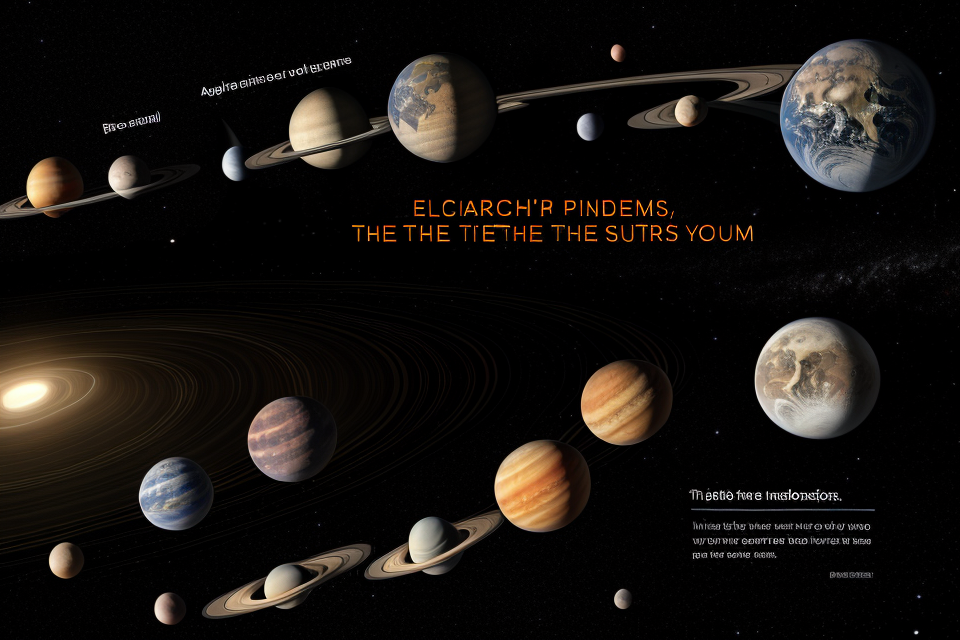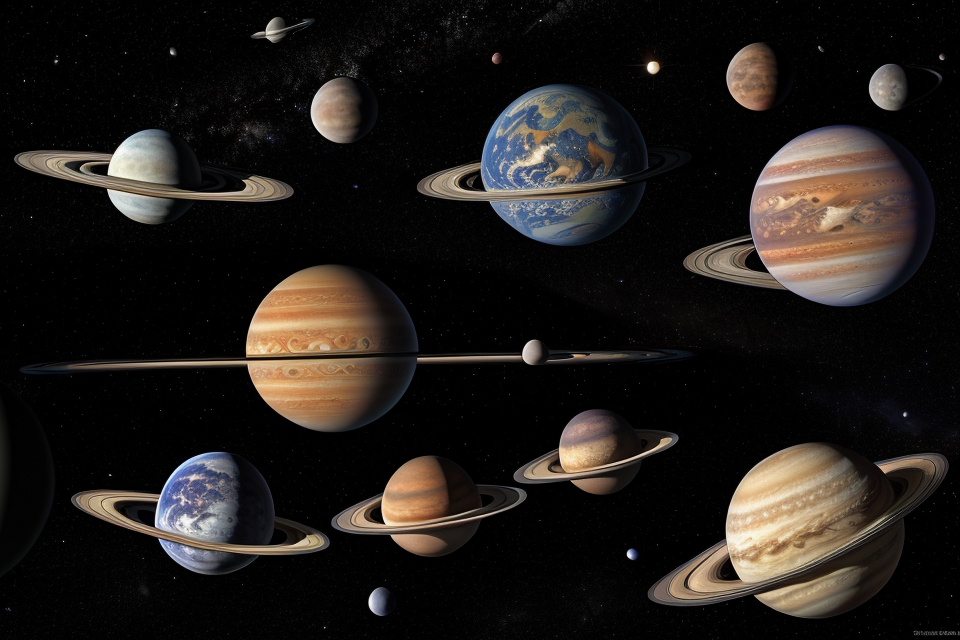The Sun, the center of the solar system, is a giant ball of hot, glowing gas. It is made up of hydrogen and helium, and it is incredibly massive. Without the Sun, the solar system would not exist. The Sun provides light and heat, making life on Earth possible. It also holds the solar system together, as its gravity keeps the planets in orbit. The Sun’s energy is responsible for driving the weather, ocean currents, and other natural processes. It is the source of energy for all living things on Earth, and without it, life as we know it would not exist. In this article, we will explore the essential role of the Sun in the solar system and how it makes life on Earth possible.
The Sun: A Comprehensive Overview
Structure and Composition
- Solar mass and size: The Sun, with a mass of approximately 330,000 times that of the Earth, is the most massive object in the solar system. It has a diameter of approximately 1.4 million kilometers, making it roughly 109 times larger than the Earth.
- Atmosphere layers: The Sun’s atmosphere is divided into three primary layers: the photosphere, the chromosphere, and the corona. The photosphere is the visible surface of the Sun, appearing as a bright yellow-white disk. Below the photosphere lies the chromosphere, which is responsible for the spectacular solar prominences and flares that can be observed on the Sun’s surface. The corona, the outermost layer, is the source of the solar wind, a continuous stream of charged particles that flows away from the Sun.
- Photosphere, chromosphere, and corona: The photosphere is the visible surface of the Sun, appearing as a bright yellow-white disk. Below the photosphere lies the chromosphere, which is responsible for the spectacular solar prominences and flares that can be observed on the Sun’s surface. The corona, the outermost layer, is the source of the solar wind, a continuous stream of charged particles that flows away from the Sun.
The Sun’s Influence on the Solar System
Heating and Cooling Mechanisms
The Sun’s influence on the solar system extends far beyond just providing light and warmth to the planets. It is responsible for heating and cooling mechanisms that regulate the temperature of the entire system. The Sun’s energy transfer through solar irradiance is a key factor in this process.
Solar irradiance is the amount of energy received from the Sun at the outer atmosphere of the Earth. This energy is transferred to the planets through a variety of mechanisms, including absorption, reflection, and emission. The amount of energy received by each planet depends on its distance from the Sun and the reflectivity of its surface.
Seasonal variations in the Sun’s energy output also play a role in the heating and cooling of the solar system. As the Sun moves across the sky, its energy output changes, causing the temperature of the planets to fluctuate. Additionally, the orbital dynamics of the planets, including their rotation and revolution, also affect the amount of energy they receive from the Sun.
Gravitational Dominance
The Sun’s role as the center of the solar system is crucial to its overall stability. The gravitational pull of the Sun is what holds the planets in orbit and determines their paths around the Sun. The orbits of the planets are stable due to the Sun’s massive gravitational pull, which keeps them from drifting away from the Sun.
The interactions between the Sun and the planets are also an important aspect of the Sun’s influence on the solar system. The Sun’s gravity is what keeps the planets in orbit, but it also affects their motion in other ways. For example, the gravitational pull of the Sun causes the tides on the Earth, which have a significant impact on the planet’s climate and weather patterns.
In addition to its gravitational dominance, the Sun’s role as the center of the solar system also affects the position and movement of the planets. The orbits of the planets are elliptical, and the Sun is at the center of each ellipse. This means that the planets are always moving relative to the Sun, and their positions and movements are constantly changing.
Overall, the Sun’s influence on the solar system is extensive and crucial to its stability and functioning. Its heating and cooling mechanisms, gravitational dominance, and position as the center of the solar system all play important roles in regulating the temperature and motion of the planets.
The Sun’s Magnetic Activity and Solar Storms
Magnetic Field and Activity Cycles
The Sun’s magnetic activity is a crucial aspect of its behavior, influencing the solar system and Earth. This activity manifests through various phenomena, such as flares, coronal mass ejections, and solar wind. To understand the Sun’s magnetic activity, it is essential to explore the structure and dynamics of its magnetic field.
The Sun’s magnetic field is a complex, interconnected system of electrically charged particles that extends far beyond the solar system. It is composed of a dipole field, with a magnetic north and south pole, and a more complex, non-dipole field, known as the “tachocline.” This tachocline lies beneath the Sun’s convective zone and is responsible for the generation of sunspots and the Sun’s overall magnetic activity.
The Sun’s magnetic activity follows an 11-year cycle, known as the “Solar Cycle.” During this cycle, the number of sunspots, flares, and coronal mass ejections increase and decrease, with the peak of activity occurring near the solar maximum. The cycle begins with a slow decline in activity, followed by a period of minimum activity, and finally, a gradual increase in activity as the cycle progresses towards the solar maximum.
The Sun’s magnetic activity manifests through various phenomena, such as solar flares and coronal mass ejections. Solar flares are sudden, intense bursts of electromagnetic radiation that occur in the Sun’s upper atmosphere, known as the corona. These flares can release an enormous amount of energy, equivalent to millions of hydrogen bombs, and can be detected across the electromagnetic spectrum.
Coronal mass ejections (CMEs) are another result of the Sun’s magnetic activity. These are large, dense clouds of plasma and magnetic field that are ejected from the Sun’s corona into the solar system. CMEs can be detected through their X-ray and extreme ultraviolet emissions, and their impact can be observed throughout the solar system.
The Sun’s magnetic activity also produces the solar wind, a continuous stream of charged particles flowing away from the Sun. The solar wind consists of a stream of protons, electrons, and heavier ions, flowing away from the Sun at a speed of about 400 km/s. The solar wind can be detected through its magnetic and electromagnetic fields, as well as its impact on the Earth’s magnetic field.
The effects of the Sun’s magnetic activity on the solar system and Earth are numerous. Solar flares and CMEs can cause geomagnetic storms in Earth’s magnetic field, disrupting communication and power systems, and affecting satellites and other technological systems. The solar wind can also interact with Earth’s magnetic field, causing aurorae to appear in the polar regions. Understanding the Sun’s magnetic activity and its effects on the solar system is crucial for predicting and mitigating the impacts of space weather on Earth.
The Sun’s Evolution and Future
Stellar Evolution Theory
The Sun is a typical main sequence star, meaning it is in the middle of its life and is fusing hydrogen into helium in its core. Over time, the Sun’s gravity will cause it to expand and become a red giant, consuming the inner planets, including Earth. However, it is important to note that this process will take billions of years.
- Main sequence stars and the Sun’s position
The Sun is a G-type main-sequence star, also known as a yellow dwarf star, located at the center of the solar system. It is about 93 million miles (150 million kilometers) away from the Earth. The Sun is classified as a G2V star, which means it is a medium-sized star that is generating energy through nuclear fusion reactions in its core.
- The future of the Sun: red giant, white dwarf, or neutron star?
In about 5 billion years, the Sun will exhaust its hydrogen fuel and enter the next stage of its life, becoming a red giant. This will cause the Sun to swell up to about 200 times its current size, engulfing the inner planets, including Earth. After this, the Sun will lose its outer layers and leave behind a white dwarf, which is a small, extremely dense remnant of a star.
However, there is a possibility that the Sun could become a neutron star instead of a white dwarf. This would happen if the Sun’s core is more massive than about 1.4 times the mass of the Sun. If this were to happen, the Sun would collapse in on itself and become a neutron star, which is an extremely dense object with a mass of about 1.5 to 3 times the mass of the Sun.
- Time scales and implications for the solar system
The future evolution of the Sun has important implications for the solar system. For example, the expansion of the Sun as a red giant will cause the outer planets to move closer to the Sun, and the inner planets will be destroyed. The Sun’s transformation into a white dwarf or neutron star will also have a significant impact on the solar system, as it will leave behind a dense remnant that could affect the orbits of the remaining planets. Overall, the future evolution of the Sun is an important factor to consider when studying the solar system and its long-term stability.
Impacts of the Sun on Earth and Human Civilization
Historical Observations and Cultural Significance
Ancient civilizations and the Sun’s significance
The Sun has been revered by ancient civilizations as a deity, symbolizing life, warmth, and light. In many cultures, the Sun was considered the center of the universe, with all other celestial bodies revolving around it. The Sun was worshipped by the ancient Egyptians, Greeks, and Romans, who believed it to be the source of all life on Earth. The ancient Egyptians, for example, dedicated their entire religion to the Sun god Ra, who was believed to create the world and control the cycles of life and death.
The discovery of heliocentrism
The idea that the Sun was at the center of the solar system was first proposed by the ancient Greek philosopher Aristarchus of Samos in the 3rd century BCE. However, it was not until the 16th century that the heliocentric model of the solar system gained widespread acceptance, thanks to the work of Copernicus, Galileo, and Kepler. This model placed the Sun at the center of the solar system, with the planets orbiting around it.
Cultural representations and mythologies
The Sun has been a recurring theme in mythology and folklore throughout history. In many cultures, the Sun was associated with gods and goddesses of light, warmth, and fertility. The ancient Greeks, for example, had a sun god named Helios, who was said to drive the sun across the sky in a chariot. The Sun has also been a symbol of power and authority in many cultures, with rulers often associating themselves with the Sun god to emphasize their divine right to rule.
Modern Astronomy and Space Exploration
Understanding the Sun through space missions and observations
The study of the Sun has been revolutionized by space exploration and modern astronomy. NASA’s Parker Solar Probe, launched in 2018, is the first spacecraft to be named after a living person (astrophysicist Eugene Parker). The probe is designed to study the Sun’s outer atmosphere and its effects on the solar system. Other space missions, such as the Solar Dynamics Observatory and the Solar and Heliospheric Observatory, have provided valuable insights into the Sun’s behavior and its impact on Earth.
Solar science and technology
The Sun’s energy and light have been harnessed for thousands of years, from the earliest use of solar power by ancient Greeks and Romans to modern solar panels and solar farms. The Sun’s energy is a clean and renewable source of power, and solar technology has the potential to provide a sustainable energy source for the future.
The role of the Sun in human space exploration
The Sun plays a crucial role in human space exploration, providing the energy and light necessary for life on Earth. It also provides the gravitational force that holds the planets in orbit around the Sun, making space travel possible. The Sun’s energy has been used to power spacecraft and satellites, and its study has helped us understand the solar system and the universe beyond.
FAQs
1. Why is the Sun so important to the solar system?
The Sun is the center of the solar system and is the source of light and heat that makes life on Earth possible. It provides energy to power the planets, moons, and other objects in the solar system, and without it, the solar system would be a cold, dark place. The Sun’s energy also drives the winds, ocean currents, and weather patterns on Earth, making it essential to our planet’s climate and ecosystems.
2. What would happen if the Sun stopped providing energy to the solar system?
If the Sun stopped providing energy to the solar system, the temperature on Earth would drop significantly, causing a new ice age. The lack of sunlight would also make it difficult for plants to photosynthesize, leading to a decline in the food chain and the extinction of many species. The atmospheres of the planets and moons in the solar system would also change, and the lack of solar wind would cause the heliosphere to collapse, allowing dangerous cosmic radiation to enter the solar system.
3. How does the Sun’s energy reach the planets in the solar system?
The Sun’s energy reaches the planets in the solar system through a process called nuclear fusion. The Sun’s core is extremely hot and dense, and the heat and pressure cause hydrogen atoms to fuse together into helium, releasing a tremendous amount of energy in the form of light and heat. This energy travels through the Sun’s atmosphere and reaches the planets, moons, and other objects in the solar system, providing them with the energy they need to survive.
4. How does the Sun’s energy affect the Earth’s climate?
The Sun’s energy affects the Earth’s climate by driving the Earth’s weather patterns and determining the amount of solar radiation that reaches the planet. The Sun’s energy warms the Earth’s surface, causing air to rise and create winds, which circulate around the planet, creating weather systems such as hurricanes, tornadoes, and thunderstorms. The amount of solar radiation that reaches the Earth also affects the Earth’s temperature, with more radiation leading to higher temperatures and vice versa.
5. Can the Sun’s energy be harnessed for use on Earth?
Yes, the Sun’s energy can be harnessed for use on Earth through a process called solar energy. Solar energy is generated by converting the Sun’s light into electricity using solar panels made of photovoltaic cells. This electricity can then be used to power homes, businesses, and industries, reducing our reliance on fossil fuels and helping to combat climate change.



